Jack Ma, the founder of Alibaba, was often asked why he chose a name that sounded Arabic and not something close to Chinese culture. He replied that the image of "open sesame" attracted him. Since he focused on small businesses and wanted them to be "open to the world." And so it happened.
Nowadays, Alibaba Group is one of the most famous and largest online trading platforms globally. It includes about 1 billion consumers in China and over 300 million consumers overseas. The Alibaba B2B website is a part of this huge company.
Let's find out how to build a marketplace like Alibaba.
Alibaba Group: overview and history
Alibaba is a huge ecommerce company that has various products. Initially, Alibaba was created so that Chinese manufacturers could interact with international buyers.
Here are some of the most well-known and lucrative platforms and products developed by Alibaba Group:
- Alibaba.com - a B2B (business-to-business) ecommerce store;
- Tmall - a B2C (business-to-customer) ecommerce platform;
- Taobao - a C2C (customer-to-customer) ecommerce website;
- AliExpress - a B2С ecommerce marketplace;
- Aliyun - a cloud computing company that offers database, elastic computing, and web hosting services;
- Alipay - an online payment app and a digital wallet service.
The story behind the famous brand
The Alibaba company was founded in Hangzhou in 1999 by a former teacher, Jack Ma, and his associates. The work began in an ordinary apartment, which was the company's office for the first years. Initially, the Alibaba.com online store was planned as a platform for small and medium-sized businesses to trade.
In late 1999, Jack Ma managed to attract early investors. They invested $25 million in the Alibaba project.
Here, you can see the first incarnation of the Alibaba website.
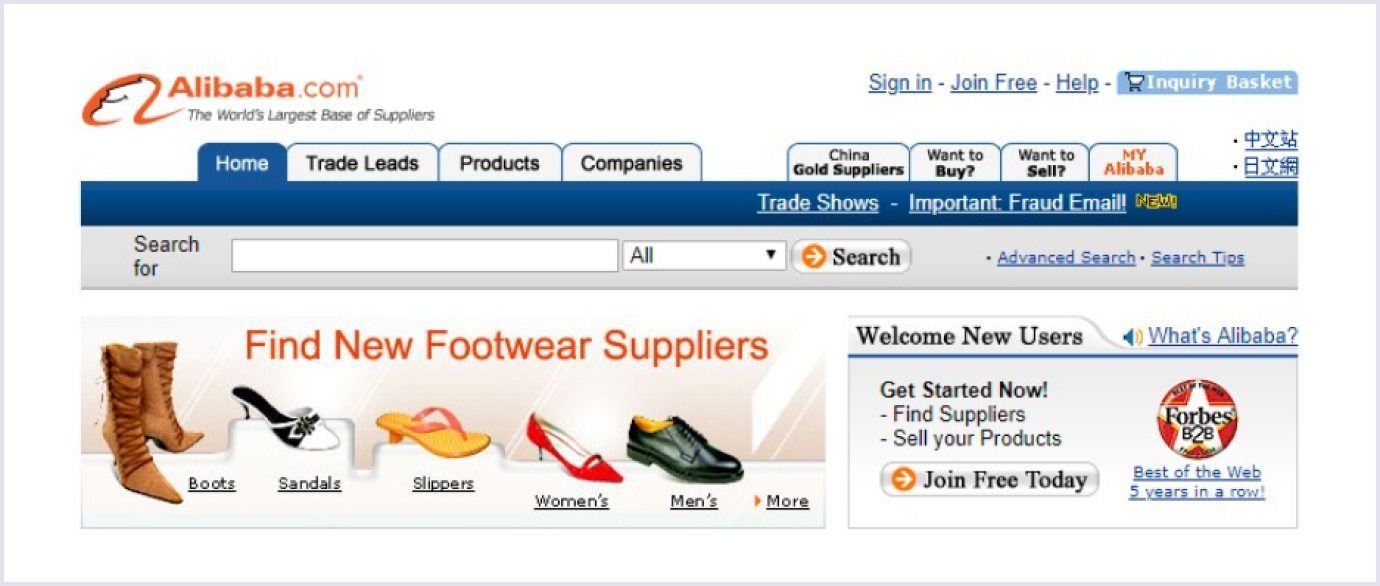
Source: Alibaba
In 2004, Alibaba Group launched the Alipay service. In addition to its primary function, Alipay protects buyers' money from scammers.
Soon, the Taobao platform was launched, and in 2005, the Alibaba Group began managing Yahoo's Chinese division. In April 2008, the Tmall website opened.
Finally, in April 2010, one of the most critical events in the history of Alibaba happened. The AliExpress platform appeared. It quickly gained worldwide fame and recognition, despite the fact that AliExpress was initially aimed at the United States.
Notably, the Alibaba website is primarily a platform for wholesale, while AliExpress is designed for retail. For end consumers, AliExpress is interesting as a vast catalog of inexpensive goods.
Alibaba's e-catalog offers almost anything for users, from agricultural equipment to various machine tools. The website has both end-use goods, such as clothing, computers, or toys, and raw materials and spare parts.
In 2021, Alibaba's net ecommerce sales reached an estimated 764 billion U.S. dollars worldwide. It is projected that this figure will increase by more than 80% by 2026, reaching a total of approximately $1.4 trillion in sales.
You may also like: How to Build a Multi-Vendor Marketplace Platform From Scratch
Core business models of Alibaba Group
The three main business directions of the Alibaba Group are organized as separate companies. These are Alibaba.com, Taobao, and Tmall.
Alibaba.com is relatively tiny compared to the overall activities of Alibaba Group, especially when compared to its Taobao and Tmall marketplaces. These platforms attract hundreds of millions of users, accounting for a significant portion of Alibaba's revenue.
Taobao is a C2C marketplace where platform members, including sellers, do not pay commissions. This marketplace generates revenue through the sale of advertising and services. For example, it boosts merchant pages in its internal search results. Taobao is focused on China.
The Tmall B2C website serves major global brands, such as Apple, Gucci, and others, selling products to Chinese buyers. Monetization occurs through an annual subscription from sellers. Revenue is generated from transactions on the service.
Both ecommerce platforms allow vendors to upload short product videos and host live streams. Thus, they engage users and increase purchase conversions.
On the other hand, AliExpress is a B2C marketplace for international online trading. To open a web store on AliExpress, sellers pay a fixed $1,500. There are also commissions for in-service services.
Below, you can see Alibaba's business model.
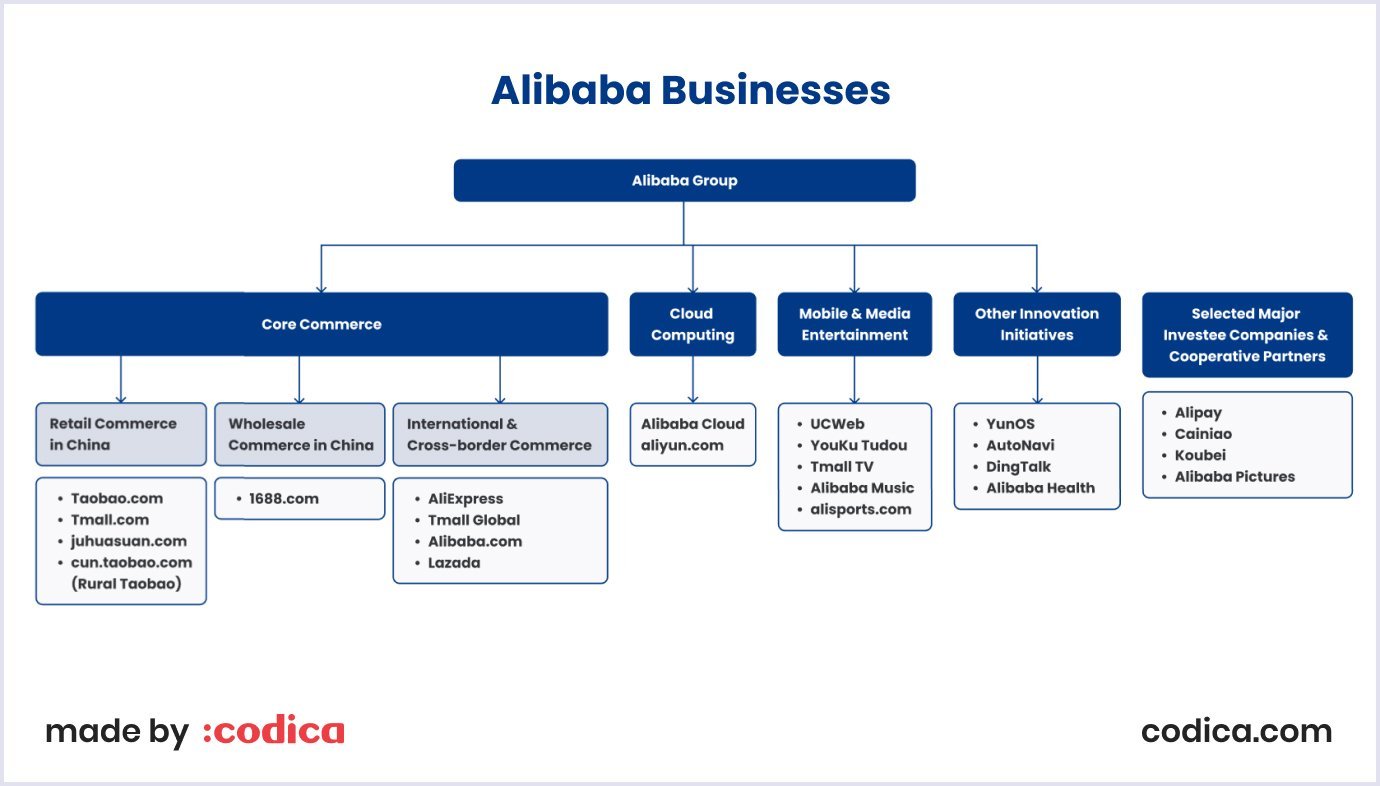
How does the Alibaba.com website work?
Alibaba.com is the leading B2B website for global wholesale, retail, and other businesses. This web solution serves millions of suppliers and consumers worldwide. On Alibaba.com, small enterprises can sell their goods to firms in other countries, thanks to the platform's comprehensive custom enterprise software development services.
Suppliers on Alibaba.com are usually distributors and manufacturers from China. They can also be from other manufacturing countries such as Pakistan, India, Thailand, and the United States.
The goal of Alibaba.com, as part of the Alibaba Group, is to simplify doing business anywhere. It provides B2B sellers with the tools to reach a global audience for their products. Additionally, Alibaba.com enables consumers to find products and sellers efficiently and quickly.
The Alibaba website brings hundreds of millions of goods in over 40 categories. These are machinery, consumer electronics, apparel, and more. Shoppers for these goods are located in over 190 countries and regions. They send hundreds of thousands of messages to sellers on the website every day.
The Alibaba B2B website continues to develop services to assist businesses in doing more and discovering new opportunities.
But what about the Alibaba website’s strategies to generate income? Let’s analyze them below.
Monetization strategies that Alibaba website uses
Registration and listing creation are cost-free. The website receives revenue primarily via Gold Supplier subscription and advertising services.
1. Advertisement services:
You can post up to 50 listings for free. However, if the money is paid through Alipay, the Alibaba website receives revenue from them in the form of commissions. Alibaba also charges sellers from Hong Kong, Taiwan, and China.
2. Gold Supplier subscription:
A Verified Supplier subscription on Alibaba is a premium membership. To become a Verified Supplier, sellers should pay fees (billed annually at $21,999).
Verified suppliers must undergo strict authentication and verification procedures. Also, they are charged commissions as a percentage of the transaction value of products sold.
Below, you can see the subscription prices on the Alibaba website.
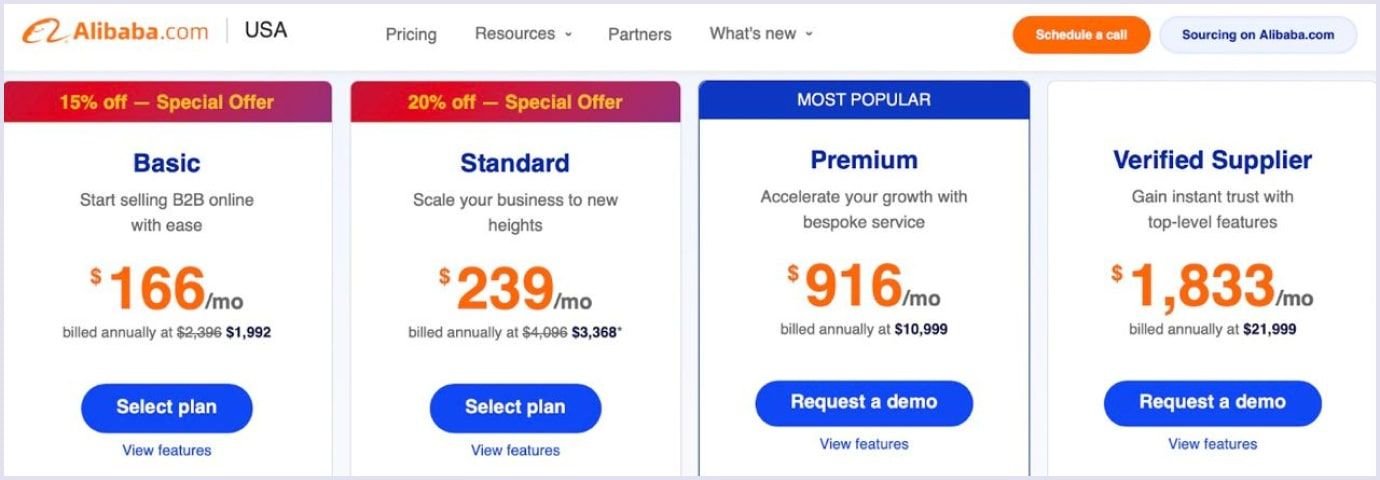
Source: Alibaba
Payment methods on the Alibaba website
Do you know about escrow payments? Using an Alibaba escrow service involves entrusting the buyer's funds to a neutral third party, who safeguards them until the buyer verifies the satisfactory receipt of their order. Only upon the buyer's confirmation does the escrow release the payment to the supplier. So, escrow is a secure payment option in Alibaba online transactions, offering protection to buyers and suppliers alike.
On the other hand, Alibaba provides various payment options. Let's check them together:
- PayPal. It is an international payment system with which consumers pay for purchases online.
- Credit card. Consumers can also quickly pay with a credit card online if they have an open bank account. These cards include VISA and MasterCard.
- Wire transfer. It is a traditional method of electronic funds transfer, allowing consumers to send money directly from one bank account to another.
- Boleto. It is a popular payment method in Brazil that allows consumers to make purchases or payments offline.
- Apple Pay. It is a digital wallet and mobile payment service provided by Apple Inc., allowing consumers to make secure payments in stores, online, and within apps using their Apple devices.
Related reading: Best Monetization Practices to Build a Successful Online Marketplace
Core features of the Alibaba e-commerce platform
When you're searching for how to create website like Alibaba, you want to know which features of Alibaba you should include.
The Alibaba marketplace offers a wide range of products and services. Therefore, this market giant has a huge number of features. Let's consider just several of its core features to help you plan your Alibaba-like website development.
Functionality for vendors
Registration
To become a supplier on a website like Alibaba, a user should register and undergo a testing procedure. Sellers should also verify their company with authentication documents on Alibaba.
Product listings management
Sellers should be able to place and manage their listings on the website.
Order management
Suppliers should be able to see the shipping status and all details about their orders.
Promotional packages
Offer an option for sellers to choose promotional packages with different costs and perks.
Messaging system
Provide a messaging channel for clear communication between buyers and sellers. It helps minimize further disputes.

Functionality for shoppers
Registration
On a website like Alibaba, new buyers should be able to register by social media or email. In addition to the standard functionality for creating a profile, buyers should be given the functionality to indicate their preferred goods. This product category is needed for personal recommendations on the site.
Convenient search
Buyers should be able to easily and quickly find what they are searching for.
Several payment options
On websites like Alibaba, customers should be able to select the payment method that is most relevant to them. You may also offer some interesting propositions. For example, Alibaba created a Pay Later service. It gives buyers up to $150,000 in credit for online shopping on the Alibaba website.
Wishlist
Buyers can add selected items to a wishlist. It helps to compare prices, wait for discounts on a particular product, etc.
Messaging
On a website like Alibaba, buyers should be able to chat with a supplier to clarify any points regarding the purchase.
Ratings and reviews
On the Alibaba website, shoppers can leave feedback and rate suppliers within two months after a sale. They rate the vendor's service, shipment speed, and quality of the goods. Thanks to the ratings, buyers can choose a reliable supplier.
Disputes
Sometimes, the quality of goods isn't satisfying for a purchaser, or they have some other claim. In that case, they can open a dispute and request a refund. So, provide this feature for your future ecommerce marketplace solution, such as Alibaba.
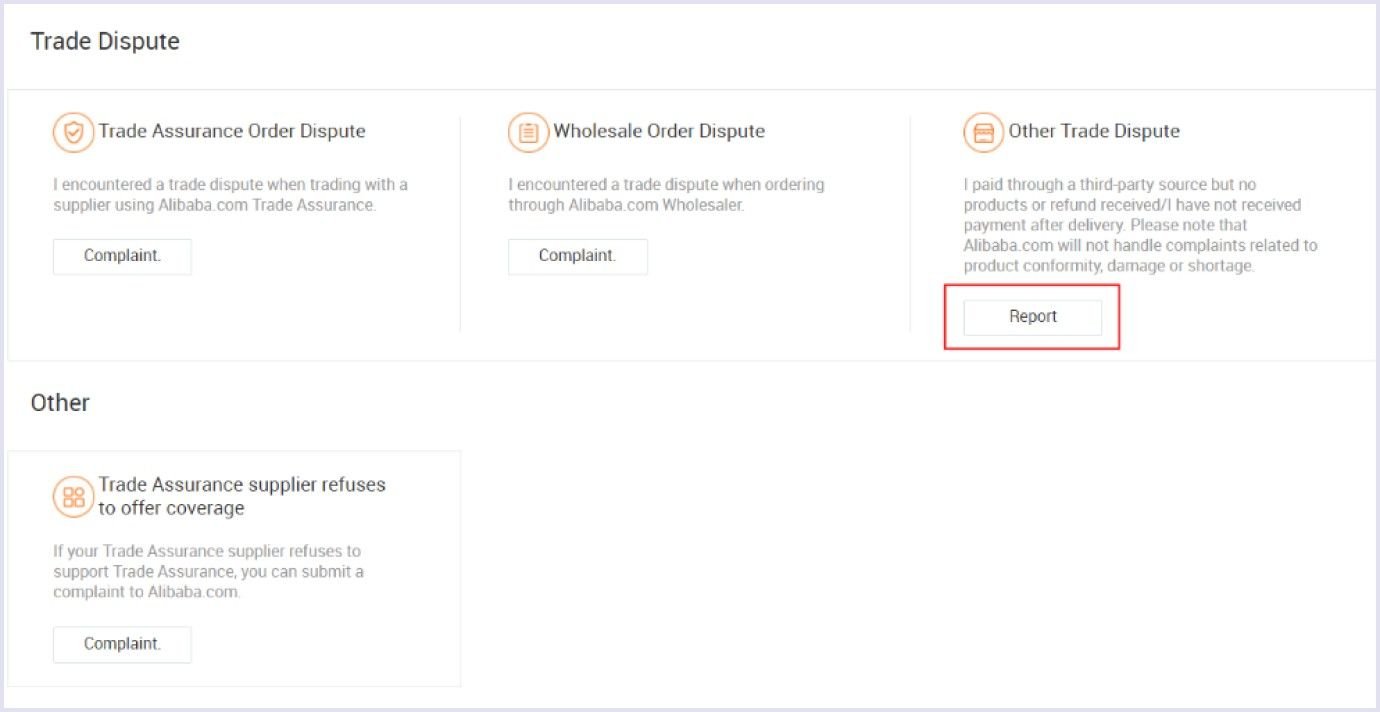
Source: Alibaba Help Center
Customer support
Shoppers and vendors may contact the Alibaba customer support center via a form on its official site. Alibaba's customer service team advises and helps users if they have problems using the platform.
You may also like: Top 16 Marketplace Features to Drive Your Business to Success
Functionality for an administrator role
Supplier approval
The administrator should change the status of a supplier profile when they have passed the verification process. Before approval, merchants can't communicate with other users, create listings, accept payments, etc.
Communication
The administrator on your website, like Alibaba, should communicate with both vendors and shoppers.
Advertisements management
This feature allows vendors to remove, change, or block listings. Also, this includes the ability to tailor product descriptions, update pricing information, and upload high-quality images or multimedia content to captivate the audience.
Content management
As a platform that hosts a diverse array of products and services, Alibaba recognizes the importance of continuously updating and enriching its content to meet its global user base's evolving needs and preferences. So, this feature on a website like Alibaba enables changing, adding, or removing the website's content.
Monetization management
The administrator can change, add, and remove commissions for the product categories. This function also means removing or entering subscriptions.
Reporting function
This function provides statistics in a convenient form. For example, these can be customer data or sales reports.
So, Alibaba is a huge marketplace with hundreds of features. It uses a complex analytical system, artificial intelligence (AI), and other advanced technologies.
AI in the Alibaba marketplace
Artificial intelligence is transforming different platforms, including the Alibaba marketplace. The platform’s AI-driven innovations encompass various aspects of enhancing customer experience and team productivity. Here are several prominent use cases:
- Product recommendations. As traditional systems failed in meeting customer demand for product discovery, Alibaba implemented a sophisticated product recommendation system. Leveraging efficient AI technologies, the company integrated the system into homepage layouts, product pages, and shopping virtual assistants. The result is improved engagement and conversions.
- Automation of logistics and warehouse operations. As the Alibaba website handles millions of transactions and many processes rely on manual input, streamlining operations was essential. That is why Alibaba implemented AI technology to help the company with predictive analytics, thereby improving demand forecasting.
- Customer service and chatbots. Rising queries were an issue for traditional customer service systems, which had to handle numerous simple queries instead of complex tasks. AI has become a solution in the form of AliMe chatbot and voice assistants for phone calls. Thanks to these advancements, the team passed 90% of routine queries to AliMe. Moreover, Alibaba implemented a live chat assistant that helps sellers with personalized answers to customer queries.
Building a website like Alibaba: a brief guide
In online marketplace development, a thorough approach is essential, from planning to maintenance and support. We know this based on our years of experience in custom software development services. Let’s explore what you need to develop your website like Alibaba, regarding how Codica approaches this process.
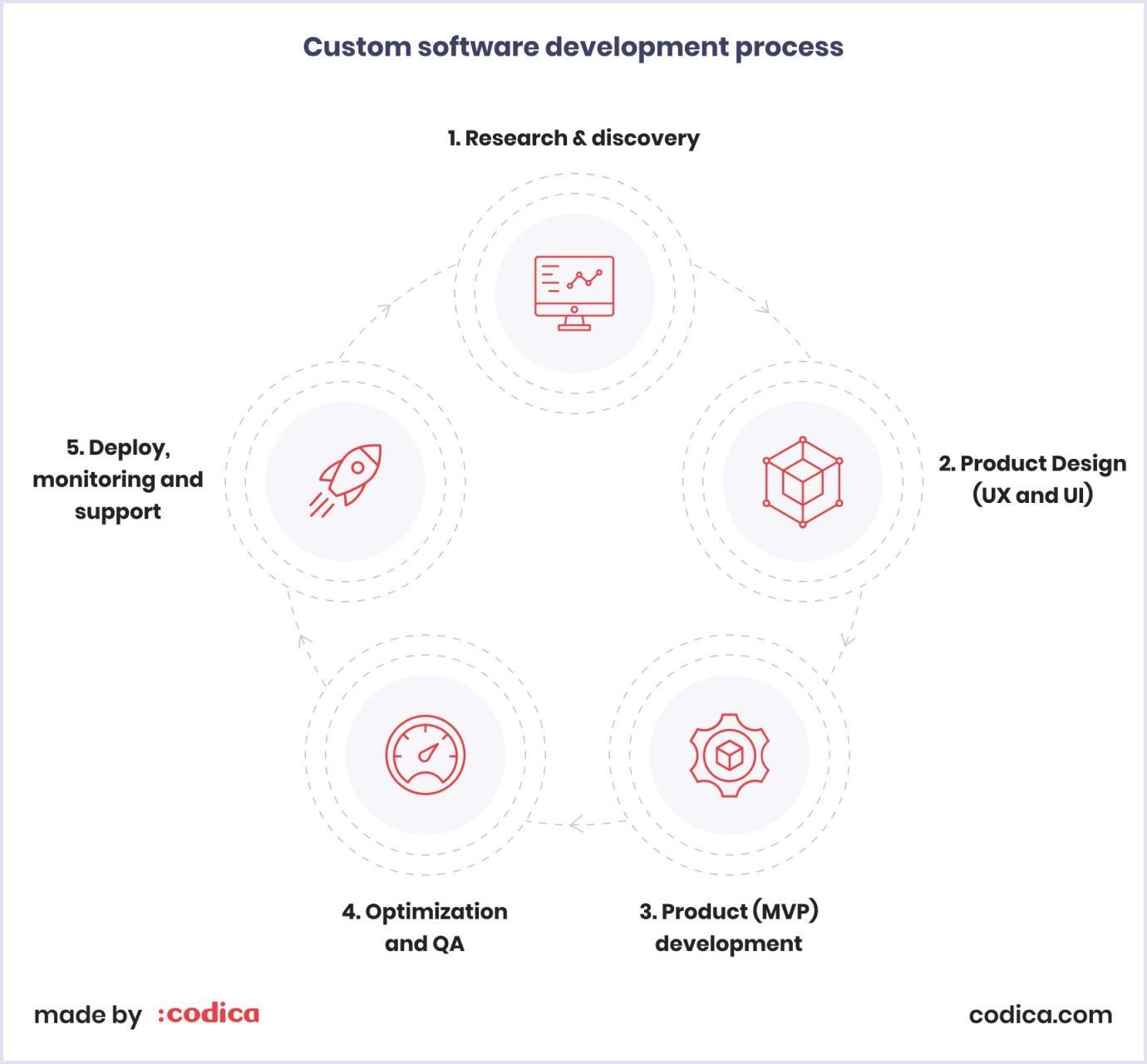
Product discovery
Starting with product discovery is an essential step. It helps you plan your marketplace development and optimize the budget and timeline.
During the project discovery phase, our team discusses with you the e-commerce store requirements, conducts a deep analysis of business aspects, and provides you with estimates. As a result, you get clickable prototypes, list of priority features, tech stack, product architecture, product specification, time and cost estimates, and recommendations on team composition.
The video from our team provides more in-depth coverage of the product discovery deliverables.
UI/UX design
This process starts during product discovery and continues after we agree with you on the project details. Our designers conduct in-depth market research to gain a deeper understanding of your audience. Also, they apply their expertise to ensure a smooth workflow in your marketplace and style consistency.
UI/UX design services are also necessary to enable designers to create guidelines for developers. It is important to streamline the development process and ensure that the designed features of your solution are implemented correctly.
Read also: Website UX Discovery Process: Roles, Tools and Main Steps in Web Design
Marketplace MVP development
Custom website creation is suitable for unique projects that want to scale their business in the future. The advantage of a custom solution is its flexibility and scalability. So, you will not have problems adding new functionality and expanding your website like Alibaba. If you choose, get ready to look for a competent web development team.
At Codica, we build marketplaces with MACH architecture, which allows for flexibility and scalability. Also, we recommend starting with MVP development services. Building your platform as an MVP first helps you test your solution with a small audience and see how your marketplace performs live, without requiring much effort.
For example, our team successfully helped create Australia's online multi-vendor marketplace for caravans. There, camper fans can sell or buy new or used caravans, motorhomes, and other recreational vehicles.
We assisted the client in creating an appealing and user-friendly online marketplace for caravans. Our experts redesigned the existing solution and created a new and clear UX and UI. We also provided the multi-vendor website with third-party integrations.
Find out more about this case study in the short video below.
By the way, you can check our portfolio to see more completed projects developed by the Codica team.
Quality assurance
After development has been finished, we conduct thorough testing. Thanks to testing automation, we can refine your solution and check that all components communicate and work properly.
In our quality assurance services, we use the best practices to perform different tests, including end-to-end testing, testing API, security, and performance. Our QA services help you reduce development costs and ensure that your platform performs according to requirements and your customers' needs.
Maintenance and support
As your website like Alibaba evolves over time, support for existing and new features and security is of utmost importance. We utilize top-rated tools to ensure that your solution receives necessary updates whenever they are required and provide other improvements based on the feedback from your customers.
How much does it cost to create a website like Alibaba?
Surely, the price of creating an ecommerce website depends on the features included. Below, we will consider the most basic of Alibaba's functions. Here, we used the average rate of web development agencies in Eastern Europe, which is $50/hour. As you can see, an estimated price for a website like Alibaba.com is $69,600 at this rate.
| How much does it cost to build a website like Alibaba? | ||
| Features | Time, hours | Cost ($50/h) |
| Design | ||
| UX development | 64 | $3,200 |
| UI development | 96 | $4,800 |
| Architecture | ||
| Project setup | 16 | $800 |
| DB structure | 32 | $1,600 |
| Integrations | ||
| Payment (Stripe or PayPal) | 64 | $3,200 |
| Shipment (Shippo) | 32 | $1,600 |
| Main functionality | ||
| Authorization and security | 72 | $3,600 |
| User profiles | 42 | $2,100 |
| Homepage | 64 | $3,200 |
| Search and filters | 72 | $3,600 |
| Product page | 42 | $2,100 |
| Reviews and ratings | 48 | $2,400 |
| Shopping cart | 64 | $3,200 |
| Notifications | 32 | $1,600 |
| Buyer panel | 120 | $6,000 |
| Seller panel | 156 | $7,800 |
| Admin panel | 120 | $6,000 |
| Wishlist | 32 | $1,600 |
| Live chat response | 16 | $800 |
| Non-development activity | ||
| Project management | 64 | $3,200 |
| Quality assurance | 96 | $4,800 |
| Code review | 48 | $2,400 |
| Total | 1392 | $69,600 |
Further reading: How Much Does it Cost to Build an Online Marketplace in 2025
Conclusion
The Alibaba website attracts suppliers and consumers with a wide range of goods, low prices, and a convenient way to purchase. Thus, sellers successfully build their businesses on the platform.
In this thorough article, we have highlighted all issues you should consider before you build a website like Alibaba. We have learned a little about Alibaba's story and how it works. Also, we defined the key features of this B2B marketplace and the monetization strategies.
Moreover, we consider one of the most secure payment systems Alibaba uses. Now, you have a clear vision of how to build a website like Alibaba and what you need for it.
If you are looking for a reliable multi-vendor marketplace development company to create a website like Alibaba, contact us. Our professionals will develop a scalable, user-friendly, and lucrative Alibaba clone for you.
